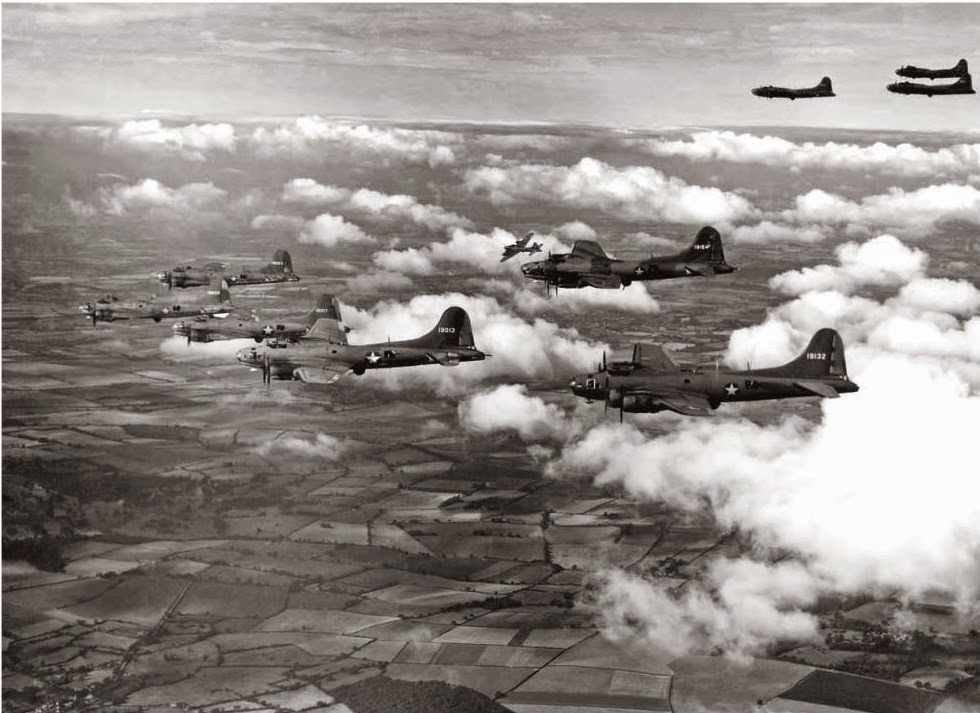Later in August, the Eighth Air Force flew its first
combat mission. Flying B-17Es, the 97th Bomb Group struck rail targets at
Rouen, France, without loss. It was an auspicious beginning to what would
become one of the longest attritional campaigns in U.S. history. Here, a
squadron of B-17s forms up over England in preparation for a mission in 1942.
Meanwhile, the build-up gained steam until
Operation Torch derailed everything. This was the invasion of Northwest Africa
by a combined Anglo-American force. To carry out this operation, the Allies
needed every available plane to support it. The Eighth was stripped of most of
its fighter units, including the 1st, 31st, and 52nd groups, and lost some of
its B-17 outfits as well. Spaatz and Eaker protested to no avail. Eventually,
the Eighth lost 1,250 aircraft and 30,000 men. The bombing campaign came to a
crashing halt. In December, the Eighth lost its talented commander, General
Spaatz to the Mediterranean theater as well. Ira Eaker took his place It would
not be until the following January that the fledglings in England would
commence large-scale bombing operations against Nazi-held Europe.
As the Americans arrived in England, then
had their build-up derailed by Torch, Bomber Command's night raids began to
cause substantial damage.
The 1943 campaign would soon begin, and
with it would come die first major contributions by the USAAF and its new fleet
of heavy bombers. Exactly how that effort would be carried out in cooperation
with the RAF dominated top-level discussions for the remainder of 1942, and
during the Churchill-Roosevelt meeting at Casablanca in January 1943.
The RAF wanted the Americans to join the
night bombing effort. Convert the Eighth Air Force to nocturnal operations and
the Allies could have a force of thousands hitting Germany by moonlight before
the end of 1943. The USAAF recoiled at the idea. The entire structure of its
strategic force had been predicated on daylight precision bombing. All the
Stateside training was geared toward this effort. Switching to night operations
would require a wholesale reconstruction of the strategic bomber force. Hap
Arnold, commander of the mid-1943. To the USAAF's materials command, hanging
gas tanks under a fighter was an anathema that would ruin the aircraft's
manoeuvrability in combat.
It would take time to sort out the fuel
tank issue and the tactics. In the meantime, the B-I 7 and B-24 crews paid the
price. The 1943 campaign would prove once and for all that if the bombers were
to survive deep penetration raids into Germany, the Mighty Eighth had to have
fighters that could go the distance with them. Wartime experience proved Billy
Mitchell right: fighter and bomber had to work together just like combined
operations in ground warfare. The cost to learn that lesson envisioned two
decades before by America's most famous airpower theorist would be dreadfully
high.
The USAAF, could not let that happen. Yet,
Churchill had already nearly sold Roosevelt on the idea of doing this.
During the Casablanca conference in January,
he cabled Eaker and told him it was up to him to save the daylight bombing
campaign. Eaker had majored in journalism in college. He sat down and drafted a
tight, one-page summary for Churchill that outlined all the reasons why
converting the Eighth Air Force to night operations would be folly. The final
sentence captured the Prime Minister's imagination.
"If the RAF continues bombing at night
and we bomb by day, we shall bomb them round the clock and the devil shall do
the rest."
Both leaders loved the idea of "round
the clock bombing." The British would batter the Germans at night while
from dawn to sunset the Americans would rule the skies. Twenty-four seven,
Germany would receive no respite from the aerial bombardment.
After Casablanca, Eaker and one of his
subordinates, General Hansell, sat down with two RAF counterparts and drafted a
detailed plan for the 1943 air campaign. Called the Combined Bomber Offensive,
the document set seventeen key target types to be attacked and destroyed during
the year. The top three included: 1) the German aircraft industry, 2) ball
bearings factories, and 3) Germany's oil refining infrastructure. Harris and
Bomber Command would still make destruction of German morale its key objective
for the year.
For both sides, 1943 would be a pivotal
period in the strategic air war. Of course, as with most wartime ventures,
nothing went as planned.

No comments:
Post a Comment